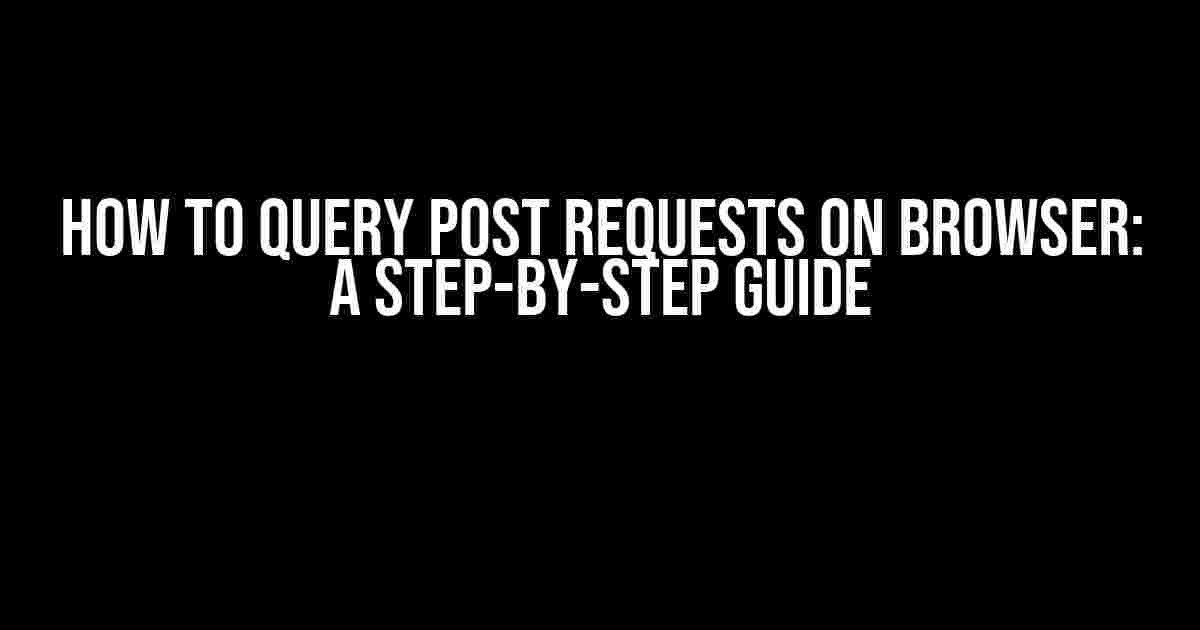Are you tired of scratching your head, trying to figure out how to query post requests on your browser? Worry no more! In this comprehensive guide, we’ll take you through the process of querying post requests on your browser, step-by-step. Whether you’re a beginner or an experienced developer, this article is designed to help you master the art of querying post requests.
What are Post Requests?
Before we dive into the nitty-gritty of querying post requests, let’s take a brief moment to understand what they are. Post requests are a type of HTTP request that allows you to send data to a server. Unlike get requests, which only retrieve data, post requests allow you to send data to the server, which can then be processed and used to perform various actions.
Why Query Post Requests?
Querying post requests is essential for a variety of reasons. Here are a few:
-
You want to analyze the data sent to the server to troubleshoot issues or identify trends.
-
You need to inspect the request and response headers to understand how the server is processing the data.
-
You want to test API endpoints to ensure they’re working as expected.
-
You need to debug issues with your application’s backend.
Querying Post Requests using Browser DevTools
One of the most popular ways to query post requests is by using the browser’s DevTools. Here’s how:
Step 1: Open DevTools
Open your browser and navigate to the webpage where you want to query the post request. Then, press Ctrl + Shift + I (Windows/Linux) or Command + Option + I (Mac) to open the DevTools.
Step 2: Switch to the Network Tab
In the DevTools window, switch to the Network tab. This tab displays a list of all the requests made by the browser, including post requests.
Step 3: Filter Requests
Click on the “Filter” button and select “XHR” (XmlHttpRequest) or “Fetch” to filter out only the post requests. You can also use the search bar to find a specific request by keyword.
Step 4: Inspect the Request
Click on the request you want to inspect, and then click on the “Headers” tab. Here, you’ll find the request headers, including the method (POST), URL, and request body.
Step 5: Inspect the Response
Click on the “Response” tab to view the response headers and body. This is where you’ll find the data sent back by the server.
// Sample Post Request
POST /api/login HTTP/1.1
Host: example.com
Content-Type: application/json
{
"username": "johnDoe",
"password": "password123"
}
Querying Post Requests using Browser Extensions
Another way to query post requests is by using browser extensions. Here are a few popular ones:
Postman
Postman is a popular extension for Chrome and Firefox that allows you to send and inspect post requests. Here’s how:
-
Install Postman from the Chrome Web Store or Firefox Add-ons.
-
Open Postman and create a new request.
-
Select the “POST” method and enter the request URL.
-
Add headers and a request body as needed.
-
Click “Send” to send the request.
-
Inspect the response in the response panel.
Requestly
Requestly is another popular extension for Chrome and Firefox that allows you to inspect and modify post requests. Here’s how:
-
Install Requestly from the Chrome Web Store or Firefox Add-ons.
-
Open Requestly and switch to the “Requests” tab.
-
Filter the requests by method (POST).
-
Click on the request you want to inspect.
-
Inspect the request and response headers and bodies.
Querying Post Requests using Command Line Tools
If you prefer using command-line tools, you can use tools like `curl` to query post requests. Here’s an example:
curl -X POST \
https://example.com/api/login \
-H 'Content-Type: application/json' \
-d '{"username": "johnDoe", "password": "password123"}'
Common Issues and Troubleshooting
When querying post requests, you may encounter issues like:
| SOLUTION | |
|---|---|
| Error 400: Bad Request | Check the request body and headers for errors. |
| Error 401: Unauthorized | Check the authentication credentials and headers. |
| Error 500: Internal Server Error | Check the server logs for errors and contact the server administrator. |
Conclusion
Querying post requests on your browser is a crucial skill for any developer or QA engineer. By using browser DevTools, browser extensions, or command-line tools, you can inspect and analyze post requests to troubleshoot issues, test API endpoints, and debug backend issues. Remember to filter requests, inspect headers and bodies, and troubleshoot common issues. Happy querying!
Related articles:
Did you find this article helpful? Share your thoughts in the comments below!
Frequently Asked Question
Got a burning question about querying post requests on a browser? We’ve got you covered!
What is the best way to query post requests on a browser?
You can use the Developer Tools in your browser to query post requests. Press F12 to open the DevTools, switch to the Network tab, and select ‘XHR’ or ‘Fetch’ to view the post requests. From there, you can filter, sort, and analyze the requests to your heart’s content!
How do I filter post requests in the browser?
Easy peasy! In the Network tab, click on the ‘Filter’ button and select ‘Method’ > ‘POST’. This will show you only the post requests. You can also use the ‘Search’ bar to search for specific keywords or URLs. Happy filtering!
Can I see the request and response bodies in the browser?
Absolutely! In the Network tab, select a post request and switch to the ‘Preview’ or ‘Response’ tab. This will show you the request and response bodies in a human-readable format. You can also use the ‘Headers’ tab to view the request and response headers.
How do I reproduce a post request in the browser?
No problem! In the Network tab, select a post request and right-click on it. Select ‘Copy’ > ‘Copy as cURL’ to copy the request as a cURL command. Then, open a new terminal or command prompt and paste the command to reproduce the request. Voilà!
What is the difference between XHR and Fetch post requests?
XHR (XMLHttpRequest) is an older technology used for making HTTP requests, while Fetch is a newer API that provides more features and flexibility. both can be used to make post requests, but Fetch is generally recommended for modern web development. Want to learn more? Check out our article on XHR vs Fetch!





